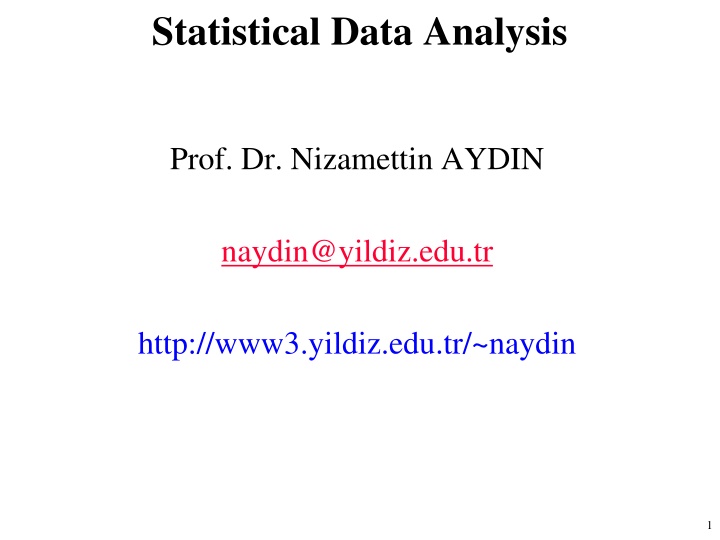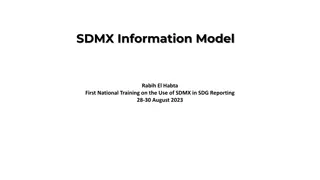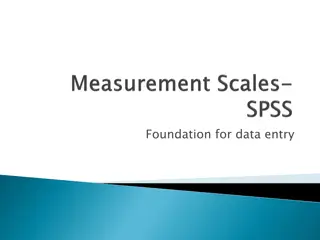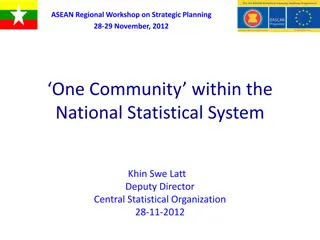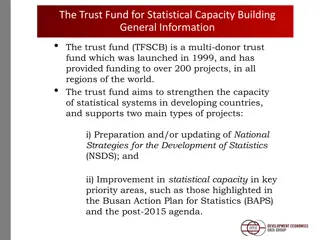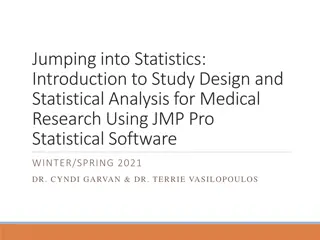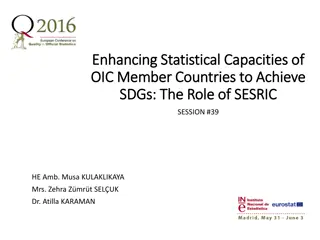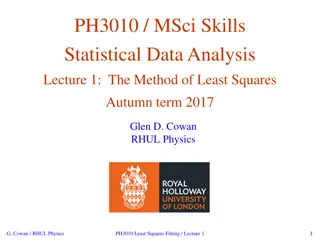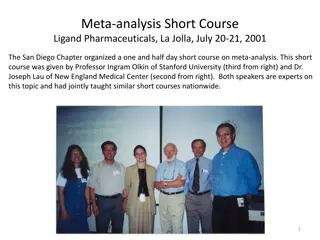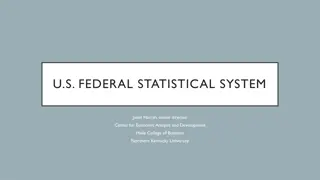Statistical Data Analysis with Prof. Dr. Nizamettin AYDIN
Statistical data analysis involves calculating probabilities for both qualitative and quantitative events, such as accidents in an automotive plant. Learn about random variables, probability distributions, qualitative and quantitative random variables, and more in this comprehensive study.
Download Presentation

Please find below an Image/Link to download the presentation.
The content on the website is provided AS IS for your information and personal use only. It may not be sold, licensed, or shared on other websites without obtaining consent from the author.If you encounter any issues during the download, it is possible that the publisher has removed the file from their server.
You are allowed to download the files provided on this website for personal or commercial use, subject to the condition that they are used lawfully. All files are the property of their respective owners.
The content on the website is provided AS IS for your information and personal use only. It may not be sold, licensed, or shared on other websites without obtaining consent from the author.
E N D
Presentation Transcript
Statistical Data Analysis Prof. Dr. Nizamettin AYDIN naydin@yildiz.edu.tr http://www3.yildiz.edu.tr/~naydin 1
Random Variables and Probability Distributions 2
Random variables We are interested in calculating the probabilities associated with both quantitative and qualitative events. For example, we can determine the probability that a machinist selected at random from the workers in a large automotive plant would suffer an accident during an 8-hour shift. We can also find the probability that a machinist selected at random would work more than 80 hours without suffering an accident. These qualitative and quantitative events can be classified as events (or outcomes) associated with qualitative and quantitative variables. 3
Qualitative Random variables For example, in the automotive plant accident study, the randomly selected machinist s accident report would consist of checking one of the following: No Accident, Minor Accident, or Major Accident. Thus, the data on 100 machinists in the study would be observations on a qualitative variable because the possible responses are the different categories of accident and are not different in any measurable, numerical amount. Because we cannot predict with certainty what type of accident a particular machinist will suffer, the variable is classified as a qualitative random variable. 4
Qualitative Random variables Other examples of qualitative random variables that are commonly measured are political party affiliation, socioeconomic status, the species of insect discovered on an apple leaf, the brand preferences of customers. There are a finite (and typically quite small) number of possible outcomes associated with any qualitative variable. 5
Quantitative Random variables Many times the events of interest in an experiment are quantitative outcomes associated with a quantitative random variable, since the possible responses vary in numerical magnitude. For example, in the automotive plant accident study, the number of consecutive 8-hour shifts between accidents for a randomly selected machinist is an observation on a quantitative random variable. Events of interest, such as the number of 8-hour shifts between accidents for a randomly selected machinist, are observations on a quantitative random variable. 6
Quantitative Random variables Other examples of quantitative random variables are: the change in earnings per share of a stock over the next quarter, the length of time a patient is in remission after a cancer treatment, the yield per acre of a new variety of wheat, the number of persons voting for the incumbent in an upcoming election. 7
Random variables Formally, a random variable X assigns a numerical value to each possible outcome (and event) of a random phenomenon. For instance, we can define X based on possible genotypes of a bi-allelic gene A as follows: In this case, the random variable assigns 0 to the outcome AA, 1 to the outcome Aa, and 2 to the outcome aa. 8
Random variables The way we specify random variables based on a specific random phenomenon is not unique. Alternatively, we can define a random variable Y as: In this case, Y assigns 0 to the homozygous event and assigns 1 to the heterozygous event. 9
Random variables When the underlying outcomes are numerical, the values the random variable assigns to each outcome can be the same as the outcome itself. For the die Rolling example, we can define a random variable Z to be equal to 1, 2, . . . , 6 for outcomes 1, 2, . . . , 6, respectively. Alternatively, we can define a random variable W and set W to 1 when the outcome is an odd number and to 2 when the outcome is an even number. The set of values that a random variable can assume is called its range. For the above examples, the range of X is {0, 1, 2}, and the range of Z is {1, 2, . . . , 6}. 10
Random variables After we define a random variable, we can find the probabilities for its possible values based on the probabilities for its underlying random phenomenon. This way, instead of talking about the probabilities for different outcomes and events, we can talk about the probability of different values for a random variable. {For example, suppose P(AA) = 0.49, P(Aa) = 0.42, and P(aa) = 0.09. Then, we can say that P(X = 0) = 0.49, i.e., X is equal to 0 with probability of 0.49.} Note that the total probability for the random variable is still 1. 11
Random variables The probability distribution of a random variable specifies its possible values (i.e., its range) and their corresponding probabilities. For the random variable X defined based on genotypes, the probability distribution can be simply specified as follows: Here, x denotes a specific value (i.e., 0, 1, or 2) of the random variable. 12
Discrete vs. continuous random variables We divide the random variables into two major groups: discrete and continuous. When observations on a quantitative random variable can assume only a countable number of values, the variable is called a discrete random variable. These variables can be categorical (nominal or ordinal), such as genotype, or counts, such as the number of patients visiting an emergency room per day 13
Discrete vs. continuous random variables When observations on a quantitative random variable can assume any one of the uncountable number of values in a line interval, the variable is called a continuous random variable. Typical continuous random variables are temperature, pressure, height, weight, and distance. The distinction between discrete and continuous random variables is pertinent when we are seeking the probabilities associated with specific values of a random variable. 14
Probability distribution The probability distribution of a random variable provides the required information to find the probability of its possible values. We need to know the probability of observing a particular sample outcome in order to make an inference about the population from which the sample was drawn. To do this, we need to know the probability associated with each value of the variable. Viewed as relative frequencies, these probabilities generate a distribution of theoretical relative frequencies called the probability distribution of the variable. 15
Probability distribution Probability distributions differ for discrete and continuous random variables. For discrete random variables, we will compute the probability of specific individual values occurring. For continuous random variables, the probability of an interval of values is the event of interest. The probability distributions discussed here are characterized by one or more parameters. The parameters of probability distributions we assume for random variables are usually unknown. 16
Probability distribution Typically, we use Greek alphabets such as and to denote these parameters and distinguish them from known values. We usually use to denote the mean of a random variable and use 2to denote its variance. For a population of size N, the mean and variance are calculated as follows: 17
Discrete probability distributions The probability distribution for a discrete random variable displays the probability P(y) associated with each value of y. This display can be presented as a table, a graph, or a formula. The probability distribution of a discrete random variable is fully defined by the probability mass function (pmf). This is a function that specifies the probability of each possible value within range of random variable. 18
Discrete probability distributions For the genotype example, the pmf of the random variable X is As another example, suppose Y is a random variable that is equal to 1 when a newborn baby has low birthweight, and is equal to 0 otherwise. We say Y is a binary random variable. Further, assume that the probability of having a low birthweight for babies is 0.3. Then the pmf for the random variable Y is 19
Discrete probability distributions Example: Probability distribution for the number of heads when two coins are tossed 20
Properties of Discrete Random Variables The probability distribution for the discrete random variable given in previous slide illustrates three important properties of discrete random variables. The probability associated with every value of y lies between 0 and 1. The sum of the probabilities for all values of y is equal to 1. The probabilities for a discrete random variable are additive. Hence, the probability that y = 1 or 2 is equal to P(1) + P(2) 21
Bernoulli Distribution Binary random variables are abundant in scientific studies. Examples include disease status (healthy and diseased), gender (male and female), survival status (dead, survived), and a gene with two possible alleles (A and a). The binary random variable X with possible values 0 and 1 has a Bernoulli distribution with parameter , where, P(X = 1) = and P(X = 0) = 1 . We denote this as X Bernoulli ( ), where 0 1. Here is unknown parameter. If were known, we could fully specify the probability mass function: P(X = x) = 1 for ? = 0 for ? = 1 22
Bernoulli Distribution For example, let X be a random variable representing the five-year survival status of breast cancer patient, where X = 1 if the patient survived and X = 0 otherwise. Suppose that the probability of survival is = 0.8: P(X = 1) = 0.8 Therefore, the probability of not surviving is P(X = 0) = 1 = 0.2 Then X has a Bernoulli distribution with parameter = 0.8, and we denote this as X Bernoulli(0.8). The pmf for this distribution is Plot of the pmf for Bernoulli(0.8) distribution P(X = x) = 0.2 ??? ? = 0 0.8 ??? ? = 1 23
Bernoulli Distribution The mean of a binary random variable, X, with Bernoulli( ) distribution is . We show this as = . In this case, the mean can be interpreted as the proportion of the population who have the outcome of interest. The variance of a random variable with Bernoulli( ) distribution is 2= (1 ) = (1 ) The standard deviation is obtained by taking the square root of variance = ?(1 ?) = (1 ) 24
Bernoulli Distribution In the above example, = 0.8. 80% of patients survive. The variance of the random variable is 2= 0.8 0.2 = 0.16, Its standard deviation is = 0.4. This reflects the extent of variability in survival status from one person to another. For this example, the amount of variation is rather small. Therefore, we expect to see many survivals (X = 1) with occasional death (X = 0). 25
Bernoulli Distribution For comparison, suppose that the probability of survival for bladder cancer is = 0.6. Then, the variance becomes 2= 0.6 (1 0.6) = 0.24. This reflects a higher variability in the survival status for bladder cancer patients compared to that of breast cancer patients. 26
Binomial Distribution A sequence of binary random variables X1, X2 , . . . , Xnis called Bernoulli trials if they all have the same Bernoulli distribution and are independent. The random variable representing the number of times the outcome of interest occurs in n Bernoulli trials (i.e., the sum of Bernoulli trials) has a Binomial(n, ) distribution, where is the probability of the outcome of interest (a.k.a. the probability of success). 27
Binomial Distribution A binomial distribution is defined by the number of Bernoulli trials n and the probability of the outcome of interest for the underlying Bernoulli trials. The pmf of a Binomial(n, ) specifies the probability of each possible value (integers from 0 through n) of the random variable. The theoretical (population) mean of a random variable Y with Binomial(n, ) distribution is = n . The theoretical (population) variance of Y is 2= n (1 ). 28
Binomial Distribution A binomial experiment is one that has the following properties: The experiment consists of n identical trials. Each trial results in one of two outcomes. We will label one outcome a success and the other a failure. The probability of success on a single trial is equal to p, and p remains the same from trial to trial. The trials are independent; that is, the outcome of one trial does not influence the outcome of any other trial. The random variable y is the number of successes observed during the n trials. 29
Binomial Distribution -Example A large power utility company uses gas turbines to generate electricity. The engineers employed at the company monitor the reliability of each turbine that is, the probability that the turbine will perform properly under standard operating conditions over a specified period of time. The engineers wanted to estimate the probability a turbine will operate successfully for 30 days after being put into service. The engineers randomly selected 75 of the 100 turbines currently in use and examined the maintenance records. They recorded the number of turbines that did not need repairs during the 30-day time period. Is this a binomial experiment? 30
Binomial Distribution -Example For solution, we check this experiment against the five characteristics of a binomial experiment. Are there identical trials? The 75 trials could be assumed identical only if the 100 turbines are the same type of turbine, are the same age, and are operated under the same conditions. Does each trial result in one of two outcomes? Yes. Each turbine either does or does not need repairs in the 30-day time period. Is the probability of success the same from trial to trial? No. If we let success denote a turbine did not need repairs, then the probability of success can change considerably from trial to trial. For example, suppose that 15 of the 100 turbines needed repairs during the 30-day inspection period. Then p, the probability of success for the first turbine examined, would be 85/100=0.85. If the first trial is a failure (turbine needed repairs), the probability that the second turbine examined did not need repairs is 85/99=0.859. Suppose that after 60 turbines have been examined, 50 did not need repairs and 10 needed repairs. The probability of success of the next (61st) turbine would be 35/40=0.875. 31
Binomial Distribution -Example Were the trials independent? Yes, provided that the failure of one turbine does not affect the performance of any other turbine. However, the trials may be dependent in certain situations. For example, suppose that a major storm occurs that results in several turbines being damaged. Then the common event, a storm, may result in a common result, the simultaneous failure of several turbines. Was the random variable of interest to the engineers the number of successes in the 75 trials? Yes. The number of turbines not needing repairs during the 30-day period was the random variable of interest. This example shows how the probability of success can change substantially from trial to trial in situations in which the sample size is a relatively large portion of the total population size. This experiment does not satisfy the properties of a binomial experiment. 32
Binomial Distribution Although it is possible to approximate P(y), the probability associated with a value of y in a binomial experiment, by using a relative frequency approach, it is easier to use a general formula for binomial probabilities. The probability of observing y successes in n trials of a binomial experiment is ?! ?! ? ? ! ?(1 )? ? where n = number of trials = probability of success on a single trial 1 - = probability of failure on a single trial y = number of successes in n trials n! = n(n-1)(n-2) . . . (3)(2)(1) ? ? = 33
Binomial Distribution - Example A new variety of turf grass has been developed for use on golf courses, with the goal of obtaining a germination rate of 85%. To evaluate the grass, 20 seeds are planted in a greenhouse so that each seed will be exposed to identical conditions. If the 85% germination rate is correct, what is the probability that 18 or more of the 20 seeds will germinate? what is the average number of seeds that will germinate in the sample of 20 seeds ? what is the variance of seeds that will germinate in the sample of 20 seeds ? what is the standard deviation of seeds that will germinate in the sample of 20 seeds ? 34
Binomial Distribution - Example Solution: ?! ?! ? ? ! ?(1 )? ? = 0.85, ? ? = n = 20, y = 18, 19, and 20 20! 18! 20 18 !(0.85)18(1 0.85)20 18= 0.229 ? ? = 18 = 20! 19! 20 19 !(0.85)19(1 0.85)20 19= 0.137 ? ? = 19 = 20! 20! 20 20 !(0.85)20(1 0.85)20 20= 0.038 ? ? 18 = ? ? = 18 + ? ? = 19 + ? ? = 20 = 0.405 The following commands in R will compute the binomial probabilities: To calculate P(X = 18), use the command dbinom(18, 20, 0.85) To calculate P(X 17), use the command pbinom (17, 20, 0.85) To calculate P(X 18), use the command 1 - pbinom(17, 20, 0.85) ? ? = 20 = 35
Binomial Distribution - Example The average number of seeds that will germinate in the sample of 20 seeds is = n = 20 0.85 = 17 The variance of seeds that will germinate in the sample of 20 seeds is 2= n (1 ) = 20 0.85 (1 0.85) = 2.55 The standard deviation of seeds that will germinate in the sample of 20 seeds is = ??(1 ?) = 2= 1.60 2= 36
Binomial Distribution - Example Suppose we examine the germination records of a large number of samples of 20 seeds each. If the germination rate has remained constant at 85%, then the average number of seeds that germinate should be close to 17 per sample. If in a particular sample of 20 seeds we determine that only 12 had germinated, would the germination rate of 85% seem consistent with our results? Using a computer software program, we can generate the probability distribution for the number of seeds that germinate in the sample of 20 seeds, as shown in the Figure 37
Binomial Distribution - Example Suppose that a sample of households is randomly selected from all the households in the city in order to estimate the percentage in which the head of the household is unemployed. To illustrate the computation of a binomial probability, suppose that the unknown percentage is actually 10% and that a sample of n = 5 (we select a small sample to make the calculation manageable) is selected from the population. What is the probability that all five heads of households are employed? 38
Binomial Distribution - Example Solution: We must carefully define which outcome we wish to call a success. For this example, we define a success as being employed. Then the probability of success when one person is selected from the population is = 0.9 (because the proportion unemployed is 0.1). We wish to find the probability that y = 5 (all five are employed) in five trials. ?! ?! ? ? ! ?(1 )? ? ? ? = 5! 5! 5 5 !(0.9)5(1 0.9)5 5= 0.59 ? ? = 5 = 39
Binomial Distribution - Example The binomial probability distribution for n = 5, = 0.9 is shown in the figure. Here, the probability of observing five employed in a sample of five is shown to be 0.59. 40
Poisson Distribution In 1837, S. D. Poisson developed a discrete probability distribution, suitably called the Poisson distribution, which has as one of its important applications the modeling of events of a particular time over a unit of time or space For example, the number of automobiles arriving at a toll booth during a given 5-minute period of time. The event of interest would be an arriving automobile, and the unit of time would be 5 minutes. 41
Poisson Distribution A second example would be the situation in which an environmentalist measures the number of PCB particles discovered in a liter of water sampled from a stream contaminated by an electronics production plant. The event would be a PCB particle discovered. The unit of space would be 1 liter of sampled water. 42
Poisson Distribution Let y be the number of events occurring during a fixed time interval of length t or a fixed region R of area or volume m(R). Then the probability distribution of y is Poisson, provided certain conditions are satisfied: Events occur one at a time; two or more events do not occur precisely at the same time or in the same space. The occurrence of an event in a given period of time or region of space is independent of the occurrence of the event in a nonoverlapping time period or region of space; that is, the occurrence (or nonoccurrence) of an event during one period or in one region does not affect the probability of an event occurring at some other time or in some other region. The expected number of events during one period or in one region, , is the same as the expected number of events in any other period or region. 43
Poisson Distribution Assuming that the above conditions hold, the Poisson probability of observing y events in a unit of time or space is given by the formula ? ? =??e ? ?! where e is a naturally occurring constant approximately equal to 2.71828 and is the average value of y. 44
Poisson Distribution - Example A large industrial plant is being planned in a rural area. As a part of the environmental impact statement, a team of wildlife scientists is surveying the number and types of small mammals in the region. Let y denote the number of field mice captured in a trap over a 24-hour period. Suppose that y has a Poisson distribution with = 2.3; that is, the average number of field mice captured per trap is 2.3. What is the probability of finding exactly four field mice in a randomly selected trap? What is the probability of finding at most four field mice in a randomly selected trap? What is the probability of finding more than four field mice in a randomly selected trap? 45
Poisson Distribution - Example The probability that a trap contains exactly four field mice is computed to be ? ? = 4 =??e ? ?! 4! The probability of finding at most four field mice in a randomly selected trap is, P(y 4) = P(y = 0) + P(y = 1) + P(y = 2) + P(y = 3) + P(y = 4) P(y 4) =0.1003 + 0.2306 + 0.2652 + 0.2033 + 0.1169 = 0.9163 The probability of finding more than four field mice in a randomly selected trap, using the idea of complementary events, is P(y > 4) = 1 - P(y 4) = 1 0.9163 = 0.0837 Thus, it is a very unlikely event to find five or more field mice in a trap. =(2.3)4e 2.3 =(27.9841)(0.10002588) 24 = 0.1169 46
Poisson Distribution - Example The Poisson probabilities can be computed using the following R commands. P(y = 4) = dpois(4, 2.3) = 0.1169022 P(y 3) = ppois(3, 2.3) = 0.7993471 P(y > 4) = 1 - P(y 4) = 1 - ppois(4, 2.3) = 0.08375072 When n is large and is small in a binomial experiment, n 100, 0.01, and n 20, the Poisson distribution provides a reasonable approximation to the binomial distribution. In applying the Poisson approximation to the binomial distribution, use = n . 47
Continuous probability distributions For discrete random variables, the pmf provides the probability of each possible value. For continuous random variables, the number of possible values is uncountable, and the probability of any specific value is zero. For these variables, we are interested in the probability that the value of the random variable is within a specific interval from x1to x2; we show this probability as P(x1< X x2). 48
Continuous probability distributions Probability distribution for a continuous random variable 49
Continuous probability distributions For continuous random variables, we use probability density functions (pdf) to specify the distribution. Using the pdf, we can obtain the probability of any interval. The assumed probability distribution for BMI (Body Mass Index), which is denoted as X, along with random sample of 100 values, which are shown as circles along the horizontal axis 50
